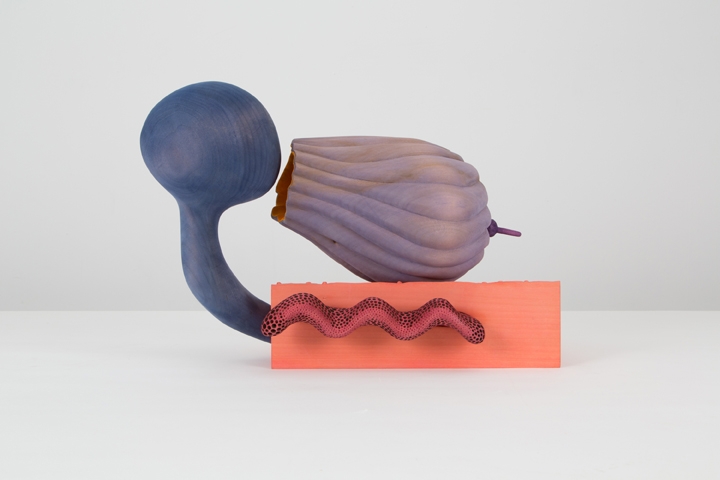Marc Foxx, Los Angeles, 29 April – 3 June 2017
Sometimes Matthew Ronay whistles in the studio ‘with a lot of vibrato’, he once confessed in an interview with David John. ‘I’m normally ecstatic in the studio,’ he continued. Ecstasy has many variants: overwhelming joy or exuberance, sexual bliss, spiritual awakening. Think Bernini’s The Ecstasy of Saint Teresa (1647–52), which exhibits a bit of each.
Ronay’s Technicolor basswood sculptures also toe the line of transcendent spirituality and out-and-out sexuality. In Thermal Organ Apparatus (all works but one 2017), a yellow-flocked phallus protrudes from a large rectangular base. In the more architectural 13 (2016), a baby-pink orifice is carved centrally into the sculpture’s backside. Some of these inclusions can feel like dude jokes, but Ronay’s formal agility produces complex formal relationships that well transcend the vulgar. Like Bernini, he creates rippling and undulating folds out of an otherwise hard material. The tabletop sculptures are exquisite puzzles of delicately carved parts, each piece stained in a unique colour. Compositionally, they would be at home with work by Ron Nagle or Peter Shire – intricate details and unexpected hues surprise at every turn.
The sculptures’ placement on low-slung pedestals encourages an intimate investigation of each work. Only when hunched over each carved microcosm can one make out brightly flocked holes or thin wood edging, which appears as malleable as Play-Doh. Scanner, more sci-fi invention than formal experimentation, consists of a large shell-like orifice resting atop a slanted pink base, which recalls both a computer keyboard and a topographic slice of land. A fistlike form juts out of this base, bending around to almost kiss the purple shell; there is a sensual tension in their almost-meeting. Like a third wheel, a wiggly pink form surprises on the backside of the sculpture, edging into the action.
Wrapped around each pedestal is a fitted cotton tablecloth, offering a bed of softness under each wooden composition. Where the sculptures are perfectly composed and solid in their forms, the fabric sits awkwardly; their hemlines fluctuate while large wrinkles make the wraps appear unconsidered and rushed. Like a rusty anchor to Ronay’s otherworldly constructions, the table dressings root the sculptures in the everyday rather than letting them expand outward into the transcendent. While individually the work in SURDS is utterly spellbinding, the installation as a whole seems to point directly to the future life of these alien objects: a quiet existence, sitting atop a swathe of linen somewhere in the Hollywood Hills.
From the Summer 2017 issue of ArtReview
